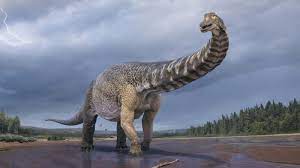In the 1960s, Australian coal miners stumbled across huge, bird-life footprints protruding from the ceiling of their subterranean work site in south-eastern Queensland. The marks, more than a foot long, belonged to a creature that trekked across swampy land around 250 million years ago. They sent paleontologists into a tizzy, who though the tracks belonged to a carnivorous dinosaur—a creature larger than any other predator of its time.
Some fossil experts across the globe had their doubts about the footprints coming from a predator, though. But they couldn’t quite disprove the carnivore idea because all they had access to was black and white photos and a drawing of the tracks. With 3D modeling technology today, researchers have been able to analyze the impressions further, and identify the mysterious creature as an herbivore from the group Prosauropoda.
“We can now make 3D models, 3D visualizations, and augmented reality so that we can get not only a clearer and more detailed understanding of the fossil that we’re examining, but also communicate that in a more complete manner,” says Anthony Romilio, paleontologist at University of Queensland and lead author on the new study published in Historical Biology. He and his team used casts of one of the prints, made by geologists and the Queensland Museum back in 1964, to create a 3D model of the dinosaur’s foot to better understand it’s entire body.
Once the track was digitized, the researchers took exact measurements from the cast and verified them with the 3D model. Back in the ‘60s, scientists had to pull estimates from the single drawing and photos; their estimates put the the print as several centimeters longer than its actual length. Without certainty of the size of the print, it’s difficult to gauge the true nature of a long-extinct dinosaur.
Using the updated dimensions, and his colleagues multiplied the length of the dinosaur’s foot by a factor of four, which gave them the rough length of the leg up the hip joint. Smaller feet mean smaller legs, helping to create a picture of the entire dinosaur that indicated it was not a predator.
Even before he knew the proper size of the creature’s feet, however, Romilio had doubts about its supposed predatory behavior. Had it been a carnivore, it would have been the biggest predator of the Triassic period—which explains all the hubbub around the discovery decades ago. But other fossil finds show that dinosaurs of the previously estimated size didn’t turn up until millions of years later during the Jurassic period.
By distilling a 3D model of the track, Romilio and his team were able to make the original discovery more accessible to paleontologists across the world. Romilio also created an augmented reality visual of the dinosaur and its footprints, so that everyone, not just researchers, could see this creature on their iPhones and iPads.
“This allowed a more comprehensive discussion about these footprints,” says Hendrick Klein, an expert on Triassic dinosaurs at the Saurierwelt Paläontologisches Museum in Germany. Romilio reached out to him for a second opinion after the study team realized the exact measurement of the foot came from a dinosaur that was smaller than imagined. Once Klein was involved, he corroborated the idea by looking at the Australian tracks against that of other Triassic herbivores.
“I remember that I had excavated footprints in North America, and had also seen similar footprints in Italy,” Klein says. “I compared Anthony’s results with these footprints, and what I distinctly saw was that they share similar morphology.”
One particular feature Klein noted was the rotation of the print. The track is directed strongly towards the midline of this creature’s foot, indicating that the dinosaur’s steps rotate inwards, a feature that isn’t typically seen among predatory dinosaurs.
Source : https://www.popsci.com/science/australian-dinosaur-footprints-correction/








